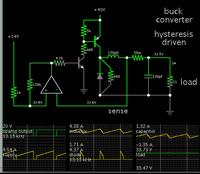David_
Advanced Member level 2

Hello.
I am designing a pre-regulator which is a step-down converter stepping down just under 40Vdc(28Vac rectified) to 3-33Vdc 0-3A, cost is a big obstacle to overcome since this is no big production and I will only make 3 PCBs to begin with.
I recon I need at least 80V rated capacitors for the input but how much capacitance do I need?
By the way, I'm using a active rectifier with MOSFETs.
Regards
- - - Updated - - -
Hmm, I might have to scrap the active rectifier.
I have never used them before and it seams as a big capacitor bank right after them is not a good idea.
I am designing a pre-regulator which is a step-down converter stepping down just under 40Vdc(28Vac rectified) to 3-33Vdc 0-3A, cost is a big obstacle to overcome since this is no big production and I will only make 3 PCBs to begin with.
I recon I need at least 80V rated capacitors for the input but how much capacitance do I need?
By the way, I'm using a active rectifier with MOSFETs.
Regards
- - - Updated - - -
Hmm, I might have to scrap the active rectifier.
I have never used them before and it seams as a big capacitor bank right after them is not a good idea.




